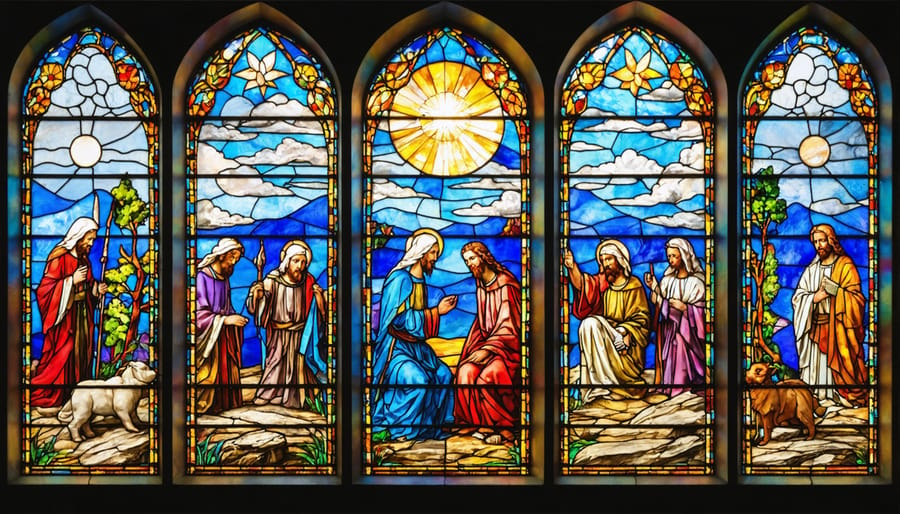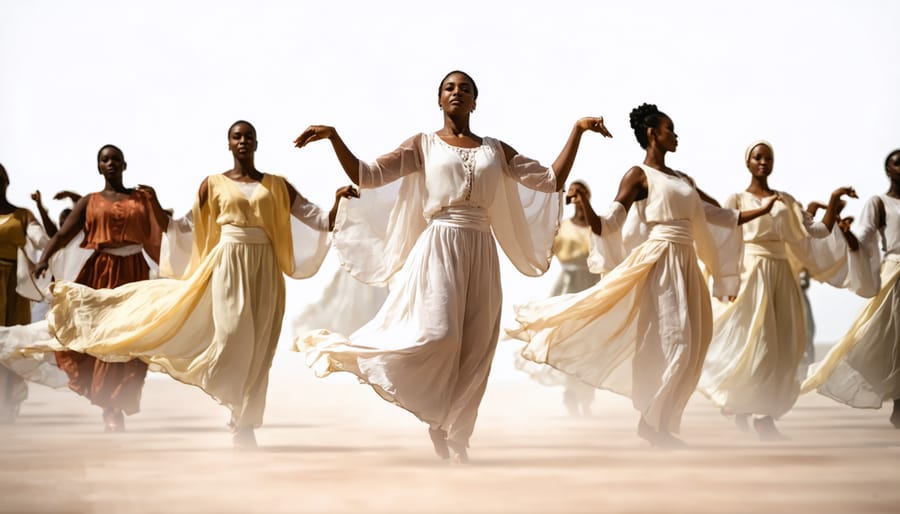Creative arts ministry transforms ordinary worship spaces into powerful encounters with God, weaving together visual art, music, dance, and drama to illuminate biblical truths in fresh, compelling ways. When brushstrokes meet Scripture and melodies merge with message, congregations experience faith through multiple senses, creating deeper connections with both divine truth and human experience.
Throughout history, from David’s psalms to medieval cathedral architecture, artistic expression has served as a vital channel for spiritual revelation and community engagement. Today’s creative arts ministry builds on this rich heritage while embracing contemporary forms of artistic expression to reach modern audiences with timeless truths.
The power of creative arts ministry lies in its unique ability to break down barriers, engage diverse learning styles, and communicate God’s message in ways that transcend cultural and generational boundaries. Whether through a powerful dance interpretation, an inspiring mural, or an innovative theatrical presentation, creative arts ministry invites both artists and audiences to encounter God’s presence through the gift of human creativity.
This ministry isn’t just about performance or decoration – it’s about creating sacred spaces where God’s truth can be experienced, understood, and embraced through the language of artistic expression.
Biblical Foundations for Creative Arts in Ministry
God as the Master Artist
At the heart of creative arts ministry lies the recognition of God’s creative nature, beautifully displayed in the opening verses of Genesis where He spoke the universe into existence. As we read in Genesis 1:1, God’s first revealed attribute is that of Creator, crafting light, land, and life with divine artistry. This fundamental truth inspires believers to embrace their own God-given creative abilities as a reflection of His image.
When we engage in artistic expression through ministry, we mirror God’s creative heart. Just as He painted the sunset, composed the songbird’s melody, and sculpted the mountains, we too are called to create beauty that glorifies Him. Psalm 19:1 reminds us that “the heavens declare the glory of God,” and through our artistic endeavors, we join in this declaration.
This divine inspiration serves as the foundation for creative arts ministry, encouraging believers to use their talents as an act of worship and a means of sharing God’s truth. Whether through music, dance, visual arts, or drama, each creative expression becomes a powerful tool for communicating God’s love and grace to others.
Biblical Examples of Creative Expression
The Bible is rich with examples of artistic expression used to worship and glorify God. In Exodus, we see God specifically gifting Bezalel and Oholiab with artistic abilities to create beautiful works for the tabernacle (Exodus 31:1-11). These craftsmen were filled with the Spirit of God to work with gold, silver, bronze, and precious stones, demonstrating that artistic talent is a divine gift.
King David, known for his musical prowess, not only played the harp but also composed numerous psalms that combined poetry and music. His artistic expressions continue to inspire worship today, showing how creative arts can transcend time and culture in praising God.
The construction of Solomon’s Temple provides another powerful example, where architecture, sculpture, and decorative arts were used to create a sacred space for worship. The detailed descriptions in 1 Kings highlight how visual arts can enhance the worship experience.
In the New Testament, we find early Christians using hymns and spiritual songs (Colossians 3:16), while the book of Revelation describes heavenly worship filled with music, symbolism, and visual imagery. These biblical examples affirm that creative expression has always been an integral part of worship and ministry.

Forms of Creative Arts Ministry
Visual Arts and Sacred Spaces
Visual expression in ministry has served as a powerful tool for worship and teaching since the early church. Through sacred visual arts, believers can create meaningful spaces that inspire contemplation and deepen spiritual connections. Paintings depicting biblical narratives help congregants visualize Scripture, while sculptures can symbolize profound spiritual truths in three-dimensional form.
Installation art in churches provides immersive experiences that engage multiple senses, creating environments where people can encounter God’s presence in unique ways. From seasonal displays that mark important religious celebrations to permanent pieces that enhance worship spaces, visual arts ministry transforms physical environments into sacred spaces that facilitate spiritual growth.
Artists within the church community can use their talents to create banners, murals, and altar pieces that reflect the congregation’s journey of faith. These works not only beautify the space but also serve as visual testimonies of God’s glory and grace. Through careful selection of colors, symbols, and materials, artists can create works that resonate with biblical themes while remaining accessible to all members of the congregation.
Music and Worship
Music has long been a cornerstone of creative arts ministry, serving as a powerful vehicle for worship, expression, and spiritual connection. Through sacred music in worship, congregations experience God’s presence in profound ways, as exemplified in Psalm 150, which calls us to praise the Lord with various instruments and jubilant songs.
Contemporary worship teams, choirs, and instrumentalists work together to create meaningful musical experiences that engage hearts and minds. This musical ministry extends beyond Sunday services to include special performances, seasonal celebrations, and community outreach events. The combination of traditional hymns and modern worship songs creates a rich tapestry that honors both heritage and current expressions of faith.
Musical expression in creative ministry also provides opportunities for individuals to use their God-given talents while fostering unity within the congregation. As Colossians 3:16 reminds us, we should “let the message of Christ dwell among you richly as you teach and admonish one another with all wisdom through psalms, hymns, and songs from the Spirit, singing to God with gratitude in your hearts.”

Drama and Storytelling
Drama and storytelling in ministry powerfully bring biblical narratives to life, creating memorable experiences that touch hearts and illuminate Scripture in fresh ways. Through carefully crafted performances, dramatic presentations can help audiences connect emotionally with biblical characters and understand complex spiritual concepts more deeply. Jesus Himself used storytelling through parables to convey profound truths, and today’s dramatic arts ministry continues this tradition.
From simple skits during Sunday services to full-scale productions at Christmas and Easter, drama ministry offers various ways to engage congregations. Short dramatic pieces can illustrate sermon points, while longer performances can explore biblical stories or contemporary Christian themes. Through mime, monologues, puppetry, and ensemble performances, drama ministers can reach diverse audiences and address different learning styles.
This ministry form also provides opportunities for community building, as participants work together to create meaningful presentations. Those involved often discover and develop their God-given talents while forming lasting friendships and growing in their faith. For youth especially, drama ministry can offer a creative outlet for expressing and exploring their faith journey.
Dance and Movement
Dance and movement in worship have deep biblical roots, from Miriam’s celebratory dance after crossing the Red Sea to David dancing before the Lord with all his might. Today’s liturgical dance ministry continues this sacred tradition, offering a powerful way to express praise, reverence, and spiritual truth through movement.
Sacred dance in worship services can take various forms, from interpretive solo performances to congregational movement. These expressions often accompany worship music, illustrate sermon points, or provide visual interpretation of Scripture passages. Movement can range from simple gestures to choreographed routines, allowing participants of all skill levels to engage meaningfully.
The incorporation of dance ministry provides unique opportunities for multi-generational participation and can help break down barriers between traditional and contemporary worship styles. When thoughtfully integrated, sacred dance can deepen the worship experience by engaging both performers and observers in physical, emotional, and spiritual ways.
For those considering implementing dance ministry, it’s important to approach it with reverence, cultural sensitivity, and clear biblical purpose. This ensures that movement enhances rather than distracts from worship, while honoring diverse worship traditions within the Body of Christ.

Building a Creative Arts Ministry
Getting Started
Launching a creative arts ministry begins with prayer and seeking God’s guidance for your vision. Start by gathering like-minded individuals who share your passion for both the arts and ministry. Together, assess your congregation’s artistic gifts and interests through informal conversations or a simple survey.
Next, schedule a meeting with your church leadership to present your vision and obtain their blessing and support. Share how creative arts can enhance worship experiences and reach people in unique ways, just as King David used music and dance to praise the Lord (Psalm 150:3-5).
Create a clear mission statement that aligns with your church’s values and objectives. For example: “To glorify God through artistic expression while nurturing creativity in our community.” Identify specific ministry areas you’ll focus on initially, such as drama, visual arts, dance, or music.
Develop a basic structure for your ministry team, assigning roles based on individual strengths and spiritual gifts. Consider appointing coordinators for different artistic disciplines and someone to handle administrative tasks.
Start small with manageable projects that can build momentum. This might include organizing a worship night featuring various art forms, creating seasonal decorations for church events, or forming a drama team for special services.
Establish regular meeting times for prayer, planning, and skill development. Create opportunities for mentorship between experienced artists and beginners. Remember to document your journey through photos and testimonies to share God’s work through your ministry.
Finally, maintain open communication with church leadership and your team, regularly evaluating and adjusting your approach as needed. Stay focused on serving others and glorifying God through your creative expressions, remembering that “whatever you do, do it all for the glory of God” (1 Corinthians 10:31).
Nurturing Artistic Gifts
Nurturing artistic gifts within a creative arts ministry requires intentional effort, mentorship, and a supportive environment where individuals can explore and develop their God-given talents. As Scripture reminds us in 1 Peter 4:10, “Each of you should use whatever gift you have received to serve others, as faithful stewards of God’s grace in its various forms.”
Creating a nurturing environment begins with recognizing and affirming the unique artistic expressions within your community. This involves identifying individuals with various creative abilities and providing them with opportunities to grow. Regular workshops, training sessions, and skill-development programs can help artists refine their craft while maintaining a spiritual focus.
Mentorship plays a crucial role in artistic development. Pairing experienced artists with emerging ones creates valuable learning relationships that encompass both technical skills and spiritual growth. These relationships can help younger artists navigate the challenges of expressing faith through art while maintaining artistic integrity.
Resources and support should extend beyond just technical training. Provide spaces for artists to practice, create, and collaborate. Consider establishing a dedicated creative space or studio where artists can work on projects, share ideas, and receive feedback from peers. Regular critique sessions, conducted with grace and encouragement, can help artists grow while maintaining a supportive atmosphere.
Spiritual formation should remain central to artistic development. Regular prayer meetings, Bible studies focused on creativity and worship, and discussions about integrating faith and art help artists understand their role in ministry. Remember that nurturing artistic gifts is not just about developing skills, but about helping individuals use their talents to glorify God and serve the church community effectively.
Creative arts ministry stands as a powerful testament to God’s creative nature and His ability to transform lives through artistic expression. As we’ve explored throughout this article, the integration of various art forms into ministry not only enriches worship experiences but also creates profound opportunities for spiritual growth, healing, and community building.
Through dance, music, visual arts, drama, and other creative expressions, individuals find new pathways to connect with God and share His message with others. These artistic endeavors serve as bridges, reaching people who might not otherwise engage with traditional ministry approaches, while offering existing church members fresh ways to deepen their faith journey.
The transformative power of creative arts in ministry extends far beyond the church walls. It touches hearts, heals wounds, and brings hope to a world desperately seeking authentic expressions of God’s love. As Psalm 96:1-3 reminds us, “Sing to the Lord a new song; sing to the Lord, all the earth. Sing to the Lord, praise his name; proclaim his salvation day after day. Declare his glory among the nations, his marvelous deeds among all peoples.”
As you consider incorporating creative arts into your ministry or participating in existing programs, remember that every artistic gift, when surrendered to God’s purpose, becomes a powerful tool for His kingdom. The future of creative arts ministry holds endless possibilities for innovation, outreach, and spiritual transformation, limited only by our willingness to step out in faith and embrace the creative calling God has placed within us.
